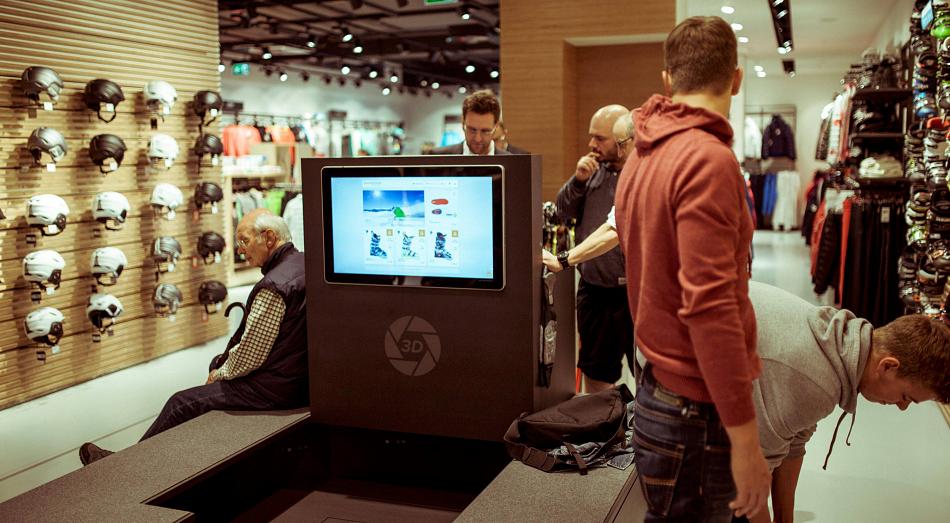Talk to me – Bots in customer communication
Interactive shopping – on the internet. Two things that, at first glance, are difficult to combine. E-commerce platforms and users/customers usually interact “statelessly”.
Many websites are already offering their customers ways to interact with a customer service team and ask questions through hotlines and live chats. These services are usually labour and cost-intensive. Thus, they are often limited to very expensive and complex products and services. Bots are going to change that.

With the advances of Artificial Intelligence (AI), new opportunities for automation in e-commerce will arise. Chatbots have the ability to receive and interpret customers’ inquiries and decide which information is being sought or which action should be taken. Actions range from showing products to more complex processes in the back end such as, for example, cancelling an order. These processes are based on learned patterns. Bots are able to learn and acquire new knowledge about processes and actions to be taken.
So what’s the difference between a bot and current search features, faceted search or FAQs? In a regular search, the quality of the results mostly depends on the quality of the search text: Are your search terms spelled correctly? Is there enough context? For example, is the user searching for a specific product type and a colour or just for a colour? Is the quality of the search index values good enough to provide accurate results? If not, it will be the user’s responsibility to find out how to change or complement his search parameters in order to get a useful result.
A bot can decide for itself if a customer’s enquiry is good enough to provide a suitable result. If not, it will try to refine the criteria through specific questions or inform the user that some important aspects are missing. It will also be able to anticipate, based on its experience and links between data sources, the user’s next steps and offer them directly as options. If, for example, the customer is looking for a specific product, the bot will offer, based on its experience, different search criteria, e.g. a price limit or the article’s colour in order to refine the search result.

Chatbot „Emma“ helps customers to find the right product. Source: https://chatshopper.com/
This will completely transform a customer’s shopping experience. Instead of accessing an online shop through landing pages and search functions, the user will be able to speak directly to a bot that will offer suggestions, show articles based on the provided information and point out discounts, bargains and other special offers. If it’s an “independent” bot, e.g. ChatShopper, the Customer Journey will start without the customer even having to access a specific online shop. The customer will interact with the chatbot through a Messenger app, like facebook messenger or WhattsApp, and be forwarded directly from there.
Even more opportunities for Conversational Commerce will arise through the increased automation in homes, the Internet of Things (IoT) and wearable devices (such as, for example, smartwatches). Devices such as Amazon’s Echo or Apple’s Siri can be an entry point for shopping or service bots to communicate with customers in powerful new ways – at least in environments where it’s possible to understand human voice.
Apart from speech recognition, there’s another area of research in AI that can be quite useful for e-commerce: image recognition. Identifying or verifying a person from a digital image has become quite common. Accordingly, bots can be used to find specific or similar articles. If the customer is using a smartphone when interacting with a bot, he may ask, for example, the bot to search for an article based on a photograph just taken with its camera. Taking it one step further, Conversational Commerce could also be applied to traditional retail stores. At peak times shop assistants are often struggling to keep up with work and cannot be available to all customers seeking help. Dedicated information terminals could help customers that are used to online shopping to find the right products in the shop. Thus, by preventing them to search the internet themselves, stores wouldn’t risk losing customers.

In SportScheck’s bricks-and-mortar shops dedicated terminals help determine the exact shoe size and propose shoes. Source: http://www.rp-online.de/nrw/staedte/krefeld/fischelner-roentgen-schuhe-fuer-den-handel-aid-1.4934231
This may sound like great potential and a bright future, but there are some hurdles to consider, though. Above all, the quality and availability of master data. Irrespective of the developments and technical achievements in Artificial Intelligence, entirely new requirements for master data and master data management systems will have to be considered. While currently there has to be just enough data for a search index and faceting, a bot will need much more information in order to be successful. In a typical faceted search, users can choose from a set of predefined, standardized options, but since a bot extracts data based on a conversation, standardization is virtually impossible.
This means that the master data will have to include, in addition to the actual values, also a network of synonyms and similar terms. In addition, the bot will need an extensive knowledge of the relationship and dependencies between the articles to make recommendations. Bots may use similar strategies to those employed by Recommendation Engines in order to gain knowledge about content relationships and dependencies, but this information may also be curated by product managers and master data experts.
Descriptions of articles should also be stored in a very granular data model. Imagine the following scenario: A user asks the bot: “Can you show me a blue T-shirt with white stars in M?” In order to find a match, all relevant search criteria have to be available as texts, i.e. data has to be granular enough to allow the bot to distinguish between a white T-Shirt with blue stars and the desired T-shirt. A comprehensive real-time full text search or real-time image recognition are out of question for performance reasons – no user would be willing to wait that long for an answer.

The Cisco Virtual Fashion Mirror gives customers a way to “try on” clothing and accessories virtually and provides customers with expert fashion advice. Source: https://www.flickr.com/photos/ciscoibsg/sets/72157628857412483/
Thus, it’s absolutely necessary to provide the right data in advance. This places additional demands on the PIM or MDM system. Relationship between items should be defined on a very granular level in order to link synonyms. In an international environment, localization management must be very efficient to maintain a high quality standard when translating texts.
The PIM’s user interface should also offer numerous options for data maintenance. Granular attribution offers a great potential for cooperation between the parties involved. Quite often, some actions are performed over and over at different stages:
- The manufacturer maintains attributes for its direct marketing and its (electronic) B2B catalogues.
- The wholesaler maintains attributes for its catalogues.
- The retailer maintains attributes for its flyers and its online shop.
- The market place adapts and complements attributes.
Quite often, the content is either identical or only marginally different. Unfortunately, the lack of industry standards in the description of articles often prevents sensible re-use and distribution of data or at least requires extensive conversions or revisions.
In order to be ready for Conversational Commerce and new Customer Journey opportunities, powerful PIM/MDM systems as well as lean and efficient processes should be set up to provide suitable data for bots. Are you wondering if it is worth the effort? According to a current survey of the industry association Bitkom, every fourth German would use chatbots. Oracle confirms: According to their study, 44% of companies surveyed intend to introduce chatbots in customer service by 2020. One thing is for sure: In just a few years, customers will be taking bots for granted and will be annoyed and disappointed if they are not available or if they don’t work well.
Ensure that your master data management and product data processes are well prepared for future developments. parsionate will support you with its extensive expertise and experience in MDM projects. A good starting point is, for example, the “Healthcheck”, where your PIM/MDM system and your processes are systematically analysed to identify and prioritize relevant measures that need to be taken in order to optimize your system. We will be happy to provide you with more information.